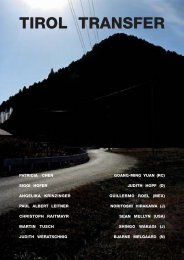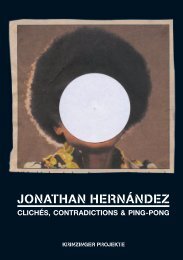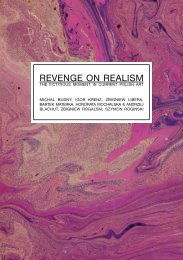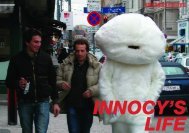post_modellismus – models in art - krinzinger projekte - Galerie ...
post_modellismus – models in art - krinzinger projekte - Galerie ...
post_modellismus – models in art - krinzinger projekte - Galerie ...
You also want an ePaper? Increase the reach of your titles
YUMPU automatically turns print PDFs into web optimized ePapers that Google loves.
a species-typical tendency, stock ga<strong>in</strong>s.)<br />
These <strong>models</strong> allegedly show a state that<br />
is still but will cease to be when the forecasts<br />
prove to be correct and the characteristic<br />
prelim<strong>in</strong>ary nature of the model<br />
becomes transformed <strong>in</strong>to someth<strong>in</strong>g def<strong>in</strong>itive.<br />
If what is prophesied becomes<br />
real, then utopia becomes reality and<br />
someth<strong>in</strong>g disconcert<strong>in</strong>g becomes completely<br />
natural.<br />
In a nutshell: the virtues of the <strong>models</strong><br />
lie, disconcert<strong>in</strong>gly enough, <strong>in</strong> the shortcom<strong>in</strong>gs<br />
conta<strong>in</strong>ed with<strong>in</strong> them. And the<br />
added value they represent can be expla<strong>in</strong>ed<br />
on the basis of the <strong>in</strong>feriority and<br />
the admitted distance to the orig<strong>in</strong>al. That<br />
they are still useful and valuable has to do<br />
with their true-to-life character, i.e., the<br />
adaptation to the human senses. Models<br />
depict th<strong>in</strong>gs and events that evade normal<br />
perception. They offer the necessary<br />
adaptation by the true-to-life shift <strong>in</strong> dimensions:<br />
urban plans become conglomerates<br />
consist<strong>in</strong>g of t<strong>in</strong>y cardboard boxes,<br />
cont<strong>in</strong>ents shr<strong>in</strong>k to the size of maps,<br />
planets to globes. By contrast, tissue samples<br />
are enlarged and atomic nucleuses<br />
are blown up so that they become large<br />
colour balls or even as architecture that<br />
can be entered. What is illustrated always<br />
loses its real dimensions, but at the same<br />
time ga<strong>in</strong>s a tangible dimension of plausibility<br />
and conviction. While temporality<br />
splits the model, and endows it with a dual<br />
rift, scale by contrast facilitates its perception<br />
and enhanced effect, but also its existence<br />
as a whole. Scale does not just separate<br />
the p<strong>art</strong>s of the model but creates<br />
a totality, which can be juxtaposed with<br />
the orig<strong>in</strong>al <strong>in</strong> a new true-to-life entity.<br />
Until now we have spoken about the effect<br />
on ontological structure and perception.<br />
The word after, which <strong>in</strong>dicates temporality,<br />
can also be used <strong>in</strong> a different<br />
sense. For after can also be understood <strong>in</strong><br />
the sense of accord<strong>in</strong>g to or correspond<strong>in</strong>g<br />
to. This, by the way, is true for both<br />
Lat<strong>in</strong> and German. And precisely <strong>in</strong> this<br />
understand<strong>in</strong>g the exhibition title and its<br />
ambitious project is enhanced with another<br />
significant variant. The <strong>art</strong>works to<br />
be seen there do not refer alone to other<br />
ones but also assimilate them. Reference<br />
and reception disrupt as it were the rupture<br />
and create a bridge, which the underscore<br />
<strong>in</strong> the title already alludes to. The<br />
referential character found <strong>in</strong> these works<br />
is ma<strong>in</strong>ly manifested <strong>in</strong> the fact that it is<br />
open to ambivalence. These <strong>models</strong> are<br />
disconcert<strong>in</strong>g, on the one hand, <strong>in</strong> that<br />
they distance themselves from precursors,<br />
but also self-evident to the extent that they<br />
assimilate them and cont<strong>in</strong>ue to reflect<br />
on them. Models, as we said, do not stick<br />
to themselves. They assume the role of<br />
another one. For the <strong>models</strong> of <strong>post</strong>_modelism<br />
it seems to be true that they understand<br />
this role first as re-flection and second<br />
as <strong>in</strong>teraction s<strong>in</strong>ce the differences<br />
between before and after no longer have<br />
to exclude each other. Thus the differences<br />
beg<strong>in</strong> to become uncerta<strong>in</strong>, the irreconcilability<br />
of model and <strong>art</strong>work, copy<br />
and orig<strong>in</strong>al, past and future, be<strong>in</strong>g and<br />
ought. Thus these oppositions become<br />
p<strong>art</strong> of a play of forces and the connect<strong>in</strong>g<br />
l<strong>in</strong>e, placed so shrewdly between these<br />
two words, proves to be a sign of exchange<br />
and its manifold back and forth.<br />
Only by aesthetic means is it possible to<br />
obta<strong>in</strong> and express how mean<strong>in</strong>gs multiply<br />
as a result of multiple references and<br />
the polar logic of model and orig<strong>in</strong>al is disrupted.<br />
And thus the exhibition shows<br />
works that seek to be both, that understand<br />
themselves as <strong>art</strong>works but still<br />
25









